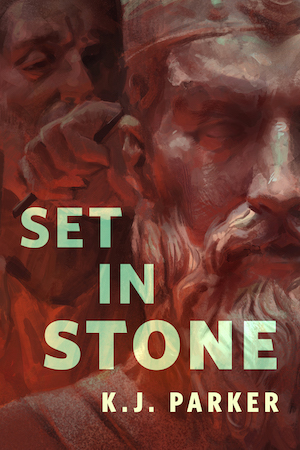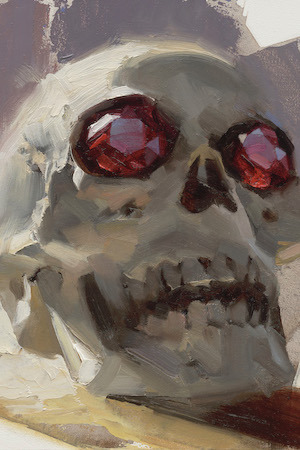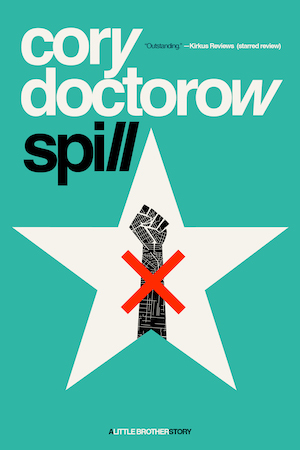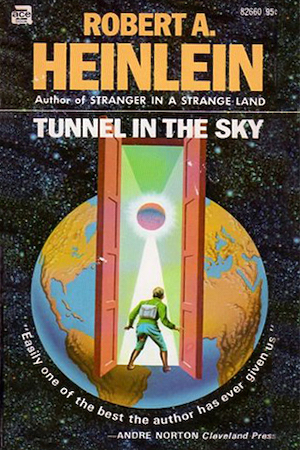In this bi-weekly series reviewing classic science fiction and fantasy books, Alan Brown looks at the front lines and frontiers of the field; books about soldiers and spacers, scientists and engineers, explorers and adventurers. Stories full of what Shakespeare used to refer to as “alarums and excursions”: battles, chases, clashes, and the stuff of excitement.
Today we’ll be discussing Tunnel in the Sky, first published in 1955, and one of the best of Robert A. Heinlein’s juveniles. Heinlein drops a group of high school students into the wilds of an alien planet for a survival test that is supposed to last only a few days. But there is a freak astronomical event, and the students find themselves abandoned; they must build a community from scratch and survive all types of threats, including swarms of vicious creatures that are almost unstoppable.
I first reviewed a Heinlein juvenile for Reactor (then Tor.com) back in 2017 by looking at my favorite, Have Spacesuit Will Travel. And now I am finishing the series on juveniles with my second favorite, Tunnel in the Sky. It has been an interesting experience watching how Heinlein’s style evolved, and how his stories moved humanity from the moon, and then to the planets, to the stars, and finally, beyond our galaxy.
I used three copies of the book for this review. The first was an Ace paperback I’d bought in high school and brought with me when I entered the Coast Guard (my name and serial number is inscribed inside the cover), and read until the cover was in tatters, the pages a pile of mostly unglued paper. The second was a Del Rey paperback edition from 1981, purchased at a B. Dalton bookstore, which I probably bought because I was tired of chasing the loose pages from my original copy. And the third copy is contained in a Science Fiction Book Club omnibus edition entitled Infinite Possibilities. This is also another Heinlein juvenile that I’ve enjoyed as an audio drama from Full Cast Audio. Reviews of this book that I found on the internet were generally positive, although more recent reviews focused on the archaic gender roles portrayed in the story. Many of the reviewers could not avoid mentioning William Golding’s 1954 book The Lord of the Flies, which also looks at a group of young people stranded in a survival situation, but with a view of human nature that is almost the exact opposite of Heinlein’s. However, I could not find evidence Heinlein had read that book, let alone intended his own work as a counterpoint to it.
In my youth, I was fascinated by survival stories, with a favorite being My Side of the Mountain by Jean George, which I also read into tatters. The idea of being able to survive on my own in the wild, and being completely independent of other people, was compelling. So the theme of Tunnel in the Sky, which dropped a group of young people into an untamed alien wilderness, grabbed me right from the start.
About the Author
Robert A. Heinlein (1907-1988) was one of America’s most widely known science fiction authors, frequently referred to as the Dean of Science Fiction. I have often discussed his work in this column, including Starship Troopers, The Moon is a Harsh Mistress, “Destination Moon” (contained in the collection Three Times Infinity), The Pursuit of the Pankera/The Number of the Beast, and Glory Road. From 1947 to 1958, he also wrote a series of a dozen juvenile novels for Charles Scribner’s Sons, a firm interested in publishing science fiction novels targeted toward young boys. These novels include a wide variety of tales, and contain some of Heinlein’s best work (the books I’ve already reviewed in this column contain links to the relevant article): Rocket Ship Galileo, Space Cadet, Red Planet, Farmer in the Sky, Between Planets, The Rolling Stones, Starman Jones, The Star Beast, Tunnel in the Sky, Time for the Stars, Citizen of the Galaxy, and Have Spacesuit—Will Travel. This is not the first time Tunnel in the Sky has been discussed on Tor.com, as Jo Walton reviewed it in 2011.
Tunnel in the Sky
Rod Walker is a high school student who dreams of working on another planet. Technology makes the trip possible through teleportation in the form of portals called Ramsbotham gates, which can be opened not only between points on a single world, but also between worlds even light-years apart. The hurdle Rod faces in pursuing his dream is passing the final exam of his Advanced Survival course, which involves students being dropped into the wilderness of an alien world for two to ten days. If they survive, they pass, and are able to work in offworld professions, but if they die, they fail. And failures do happen. Participants not only have to worry about alien creatures, but also the other students, as there are no rules preventing them from stealing from each other, or even committing violence.
While it is only implied by the text of the book, probably due to editorial intervention, Heinlein, whose juveniles often stressed diversity, intended Rod to be Black. And the text is clear in describing the other students to be from a variety of nations, races, and religions. Rod’s instructor is “Deacon” Matson, a tough customer with an eyepatch and a history of surviving offworld expeditions. Matson is one of those characters that Heinlein uses throughout his work as a conduit for the author to pontificate and share his philosophy. Matson even suggests that Rod may not be cut out for offworld survival, but Rod ignores him, showing the determination, or stubborn streak, which is his strongest personality trait. His friend Jimmy decides not to take the exam at the last minute, and while Rod’s parents are not happy about him taking the exam, he gets advice from his sister, a professional soldier in an “Amazon” unit.
On his way home from school through the gate system, Rod pauses to watch the gates in operation. He sees settlers leaving for other worlds, and in one case, a stream of people from a growing Chinese empire, which despite conquering other nations, still does not have enough room for its people. The obsession with overpopulation as a source of impending doom, so prominent throughout Heinlein’s juvenile series, is on full display here.
Rod is warned to “beware of stobor,” which he imagines is some sort of fierce beast, steps through the gate into a forest environment, and survives his first night in a tree. But during the next day, someone jumps him from behind, knocks him out, and steals everything he carries except for his shorts and a spare knife he had strapped to his leg under a bandage. Soon, he is gaunt from hunger and feverish from wounds. And he has completely lost track of time. He meets a slender young man named Jack, and they talk about teaming up, but Rod is on guard from the start because Jack is using his favorite knife, stolen by whoever jumped him. Jack explains that that the latest date for their recall gate to open has come and gone, which indicates something is terribly wrong with the exam process. He also explains that he collected Rod’s knife off a corpse, so whoever attacked Jack has found a crude form of justice.
The two come across Rod’s friend Jimmy, who had changed his mind, and taken the exam after all. Jimmy has not been doing well, but is alert enough to see something Rod missed; Jack is Jacqueline, a girl (Rod shares the cluelessness toward romance that marks so many other Heinlein juvenile protagonists). And over time, their little group begins to grow, with Rod becoming a competent outdoorsman and hunter. Eventually they encounter other groups, some of them consisting of college students, and before long Rod finds himself answering to elected leaders who majored in government. This sets up a standard plot for a lot of science fiction stories from the mid- to late 20th century: a warrior or person of action warns against complacency, concerned by possible threats, only to be ignored by political leaders, with disastrous results (Jerry Pournelle was especially fond of this premise). Students begin to pair off, marrying and even having children. A Zulu girl named Caroline becomes a compelling character, and had it not been for editorial direction to avoid romance, the reader imagines that Rod and Caroline could have become a couple. The colony builds a base in a spot that is comfortable, but not easily defensible. And when a normally docile creature turns out to be seasonally violent, the students think they have finally found the “stobor” they were warned about.
The struggle to survive is vividly portrayed, and the book contains some of the most compelling passages in Heinlein’s juveniles. At one point, Heinlein effectively uses the epistolary form of a diary to keep the reader guessing, and show the passage of time. Rod’s determination and sense of duty serve him well during the colony’s time of testing. Months become years, and the students begin to think they will never see their homes again. But the real test comes when the inhabitants of a colony who have grown into adulthood are finally brought back in touch with civilization, a place where they are still considered children. At this point, Rod’s stubborn nature, which served him so well in the wilderness, becomes a stumbling block.
The book is compelling from beginning to end, and a constant sense of jeopardy keeps the reader turning pages. The characters are well-drawn, the conflict with nature and between people is plausible, and the building of a new community is a fascinating endeavor. All in all, this is one of the best of Heinlein’s juveniles.
Rating the Heinlein Juveniles
Heinlein’s juveniles were an important part of the science fiction’s coming of age as a serious genre. Unlike other science fiction books written for young readers, they treated scientific issues with respect, and didn’t shy away from showing readers how things might work as humanity moved out into space. While exposition sometimes bogs down narratives, Heinlein had a gift for making scientific explanations come to life, and these passages often feature as one of the most interesting parts of the story. You don’t have to look far to find engineers and scientists who were inspired to join their fields because of Heinlein’s work.
There is a lot in the stories that has held up well over the years. Much of the science is solid, although new discoveries about the solar system have made Heinlein’s ideas about the other worlds obsolete. And the explosion of electronic communications and computing devices makes some of his projections feel quaint and outdated. Where the stories feel the most dated, however, are in gender roles. The books were written about and for boys at a time when the sexes were segregated in many ways. Heinlein’s portrayals of submissive wives and mothers felt over the top even when I read them back in my youth, and feel especially jarring today, in a world where gender roles are more equal. There are some who argue those attitudes make the books unreadable, but I feel that, with some discussion and context provided by parents, there is still much in them that today’s younger readers will enjoy and learn from.
It is ironic that the juveniles, where the protagonists were barred from even thinking about sex and romance by editorial dictates, almost all contain plots driven by the threat of overpopulation, the consequences on the macro level of the very procreation Heinlein was prevented from discussing in relation to his characters and their lives.
I’ve enjoyed re-reading the juveniles as an adult, and in filling in the gaps by catching up on those I had missed. They made me feel like a kid again, reliving the excitement and sense of wonder they evoked the first time around. As an older reader, however, some of those older characters that deliver Heinlein’s authorial lectures, and who seemed so wise in my youth, felt a bit smug and condescending.
Today’s adult readers can still find much in the stories to enjoy. To me, the juveniles are among Heinlein’s best works, and are preferrable to many of his later works, which suffered from self-indulgence and a lack of firm editorial guidance. Heinlein might have chafed at those editors when the juveniles were written, but they goaded him into producing some of the finest work of his career.
At this point, I can’t resist the temptation to rank the books based entirely on my own preferences. This was a highly subjective process, especially as I only encountered half of the books in my youth, and those that I read first tend to fall higher on the list. I find that the books I prefer tended to have some sort of physical challenge to overcome, and treks to survive in hostile environments are among the most memorable scenes. I also find that books that feature battles or revolutions caught my attention, although Heinlein had a knack to make even subjects like farming interesting and quite compelling. There were some instances where particular themes and situations were shared and repeated between books—such as finding out that an alien pet was more than it appeared to be, or an encounter with an enigmatic alien race that turned hostile—and I generally tend to prefer the first book I’d encountered whenever that sort of repetition occurred. I’ll also note that on occasion the strength of a single fascinating character (like the competent bureaucrat Mr. Kiku) moved a book up a few notches in my estimation.
After reading all the juveniles, I can now appreciate the overall arc of the tales. While they are not strictly sequels, and not all set in the same future history, the books do start with a trip to the moon, and end with a trip outside our galaxy, showing humanity moving farther out from Earth. There’s also a diversity of characters and situations that keep the stories interesting. Without further ado, here is my ranking of the twelve juvenile books published by Scribners:
- Have Spacesuit Will Travel
- Tunnel in the Sky
- Red Planet
- Between Planets
- Citizen of the Galaxy
- Farmer in the Sky
- Starman Jones
- Space Cadet
- The Rolling Stones
- The Star Beast
- Rocket Ship Galileo
- Time for the Stars
Final Thoughts
Tunnel in the Sky stands as one of Heinlein’s best juveniles, and one of his best books overall, for that matter. It features a lot of action and adventure, but also gives the reader something to think about regarding human nature. It is what we in New England call a “wicked good story.”
Now, I’m interested in what you have to say about Tunnel in the Sky in particular and Heinlein’s juveniles in general. And how would you rank the books yourself?










